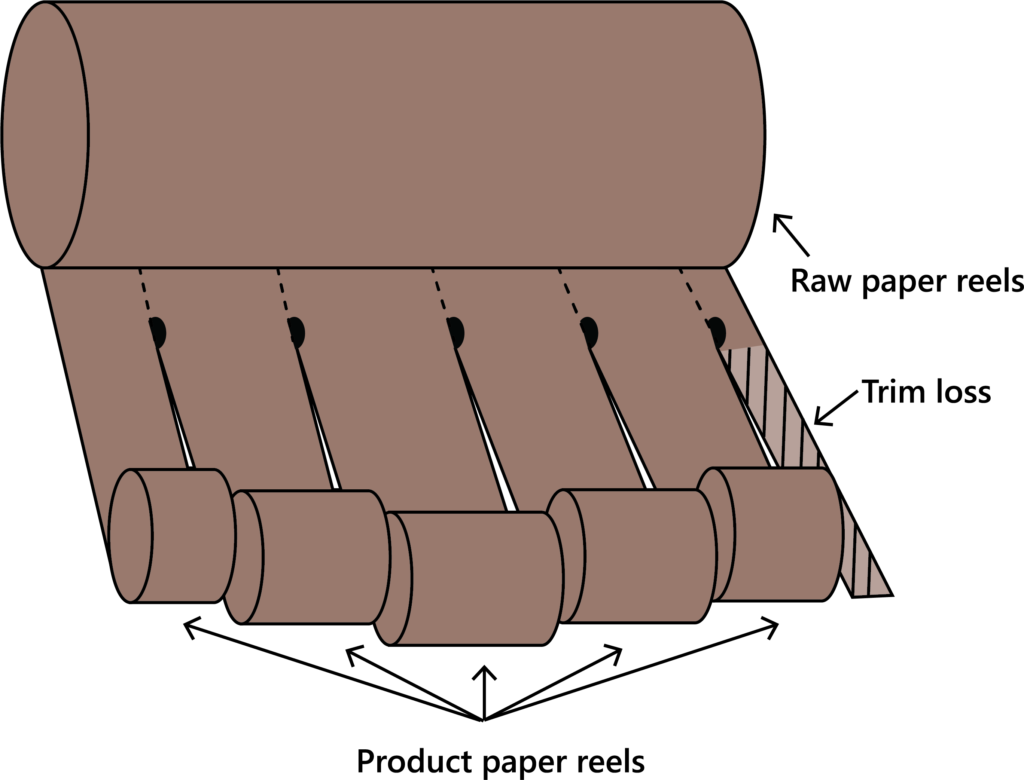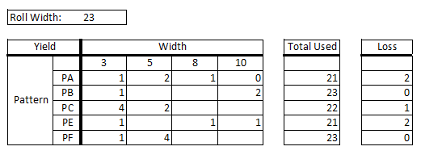Every industry from the production of cosmetics to chemicals to hospitals has complexity in its manufacturing details that often drives an emphasis on reducing production inefficiencies. In paper, this is the “trim/loss” challenge, where the basic idea is to minimize waste (unused core paper) while meeting production targets. However, this emphasis can blind the organization from the need to optimize the entire supply chain, which can create disasters larger than the failure to intelligently handle a trim loss. In this blog, we will explain the basics of trim/loss and further explore the potential disasters from failing to manage the big picture.
Trim loss optimization is a special case of Cutting Stock problems, which have been studied in depth for over sixty years. Although computing power has allowed us to handle larger and larger problems, they are still computationally intensive and so must be approached intelligently. The foundation of this work was laid by Gilmore & Gomory in 1961.
Trim Loss Optimization is a common challenge in not just paper, but also in the film, fabric, and glass industries. It comes into play when part of the production process involves producing large rolls, or reels, cutting them into narrower reels, and then ultimately into the finished products. Determining the number of slits and the distance between them depends on the various widths of the end products and the width of the large reels. As you can imagine, there are many possible patterns, each with a different combination of resulting sub-rolls. Associated with each pattern will likely be some material that is too narrow to make a sub-roll. We call this trim loss.

For example, consider a 23-foot-wide reel. End products require widths of either 3, 5, 8, or 10 feet. Below you can see five different patterns and the resulting trim loss.

To solve this problem, you would first have to come up with a set of feasible patterns. You would not have to include every possible pattern since some would never be considered. For example, any pattern with trim loss wider than the narrowest sub-roll does not make sense.
Next, you must determine what mix of patterns will give you enough of each of the sub-rolls. Invariably, you’ll end up with more of some in order to get enough of others. And of course, you want to minimize total trim loss. One way to do this might be to start with the patterns that produce the largest sub-rolls and choose enough of those to satisfy those requirements. Next, you can look at the next largest sub-roll and see how many you can get from what you’ve already selected. Then determine additional rolls needed to fill the rest of the requirements. After that, you can work on the next size, seeing what you get with what you’ve already pulled, and so on.
Most likely though, plant managers have a sense of what they need by virtue of years of experience, and they do quite well. However, as we all know, this experience is anchored to a set of historical demand patterns and products. If one or both changes, then a new set of solutions is needed. Developing this experience takes time and trial and error.
So how can you do better?
To do better, you must define what “better” means to you. In the context of trim loss optimization, better means less waste. But you are managing a supply chain and there is more to think about than just waste. For example, you must also be sure you are meeting demand on time while keeping inventory levels down. Many firms have found optimization methods to be the driver for powerful decision support tools that consider all aspects of the supply chain.
Most traditional supply chain planning models do not explicitly include the cost of waste. It is usually tied to the standard production cost because the same amount of waste is created regardless of the production process or the scheduling of jobs (changeovers not included). However, in industries like paper, the amount of waste is directly related to how plant managers run their production processes, i.e., the patterns they use. Less waste means having to buy less raw materials, so it is important to consider this cost.
As significant as the cost of trim loss is, it is also important not to look at this cost by itself. Some patterns may generate more waste but also more profitable products. Other patterns may yield the product you need, but also some products that you do not, which drives up inventory. As with most supply chain management decisions, it is imperative to look at all costs, as well as any relevant business policies, in one integrated suite of solutions. Costs to consider include purchasing, production, waste, inventory, and distribution. An example of a business policy to consider is how you manage unmet demand. Is it lost, rolled into the next planning period, or not allowed at all?
Optimization tools not only evaluate the myriad options for the right mix of patterns, but it will do so in a way that balances all costs, as well as other operating and business constraints, such as capacity limits and demand requirements. It will guarantee a production plan that uses a mix of patterns that will satisfy your demand in a way that minimizes total cost (or maximize profit if you include revenue data.) In addition to an optimal production plan, you will also get guaranteed optimal plans for procurement, inventory, and distribution.
When the trim optimization question is asked in the right way as described above, it can form a complex mathematical problem. Optimization routines might not be able to quickly get to the best pattern; this can be helped by providing a list of feasible patterns. Developing a list of feasible patterns is done as a precursor to solving the optimization problem and can be done with heuristics. Nonetheless, optimization models will provide systemic, integrated supply chain plans that breakdown silo management and gives you the best plan possible.
Enjoyed this post? Subscribe or follow Arkieva on Linkedin, Twitter, and Facebook for blog updates.





